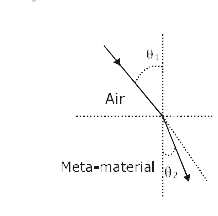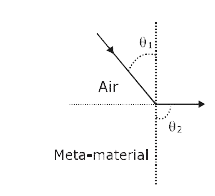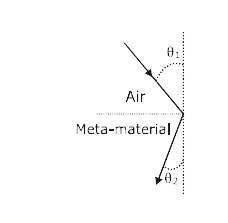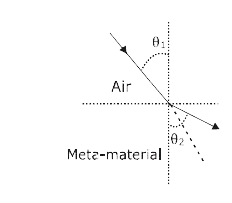Most materials have the refractive index, n>1. So, when a light ray from air enters a naturally occuring material, then by Snell's law, sinθ1sinθ2=n1n2, it is understood that the refracted ray bends towards the normal. But it never emerges on the same side of the normal as the incident ray. According to electromagnetism, the refractive index of the medium is given by the relation, n=(c/v)=±√εr,μr, where c is the speed of the electromagnetic waves in vacuum, v its speed in the medium, εr and μr are negative, one must choose the negative root of n. Such negative refractive index materials can now be artifically prepared and are called meta-materials. They exhibit significantly different optical behaviour, without violating any physical laws. Since n is negative, it results in a change in the direction of propagation of the refracted light. However, similar to normal materials, the frequency of light remains unchanged upon refraction even in meta-materials.
Answer the following questions :
For light incident from air on a meta-material, the appropriate ray diagram is




The correct Answer is:C
Step by step video, text & image solution for Most materials have the refractive index, n gt 1. So, when a light ray from air enters a naturally occuring material, then by Snell's law, (sin theta_(1))/(sin theta_(2)) = (n_(1))/(n_(2)), it is understood that the refracted ray bends towards the normal. But it never emerges on the same side of the normal as the incident ray. According to electromagnetism, the refractive index of the medium is given by the relation, n = (c // v) = +- sqrt(epsilon_(r ), mu_(r )), where c is the speed of the electromagnetic waves in vacuum, v its speed in the medium, epsilon_( r) and mu_( r) are negative, one must choose the negative root of n. Such negative refractive index materials can now be artifically prepared and are called meta-materials. They exhibit significantly different optical behaviour, without violating any physical laws. Since n is negative, it results in a change in the direction of propagation of the refracted light. However, similar to normal materials, the frequency of light remains unchanged upon refraction even in meta-materials. Answer the following questions : For light incident from air on a meta-material, the appropriate ray diagram is by Physics experts to help you in doubts & scoring excellent marks in Class 12 exams.
Topper's Solved these Questions
Similar Questions
A fish looking up through the water sees the outside world contained in a circular horizon. If the refractive index of water is 43 and the fish is 12 cm below the surface, the radius of this circle is cm is
03:23View SolutionWater is filled in a container upto height 3m. A small hole of area 'a' is punched in the wall of the container at a height 52.5 cm from the bottom. The cross sectional area of the container is A. If a/A=0.1 then v2 is (where v is the velocity of water coming out of the hole)
02:28View SolutionSuppose the gravitational force varies inversely as the nth power of distance. Then the time period of a planet in circular orbit of radius 'R' around the sun will be proportional to
01:49View SolutionWhen a ray of light is incident normally on one refracting surface of an equilateral prism (Refractive index of the material of the prism =1.5
01:12View SolutionThe refractive index of the material of a concave lens is n . It is immersed in a medium of refractive index n_(1) . A paprallel beam of light is incident on the lens. Trace the path of emerged rays in each of the following cases : (a) n_(1) gt n (b) n_(1) lt n ( c) n_(1) = n .
01:12View SolutionMost materials have the refractive index, n>1. So, when a light ray from air enters a naturally occuring material, then by Snell's law, sinθ1sinθ2=n1n2, it is understood that the refracted ray bends towards the normal. But it never emerges on the same side of the normal as the incident ray. According to electromagnetism, the refractive index of the medium is given by the relation, n=(c/v)=±√εr,μr, where c is the speed of the electromagnetic waves in vacuum, v its speed in the medium, εr and μr are negative, one must choose the negative root of n. Such negative refractive index materials can now be artifically prepared and are called meta-materials. They exhibit significantly different optical behaviour, without violating any physical laws. Since n is negative, it results in a change in the direction of propagation of the refracted light. However, similar to normal materials, the frequency of light remains unchanged upon refraction even in meta-materials.
Answer the following questions :
For light incident from air on a meta-material, the appropriate ray diagram is01:46View SolutionMost materials have the refractive index, n>1. So, when a light ray from air enters a naturally occuring material, then by Snell's law, sinθ1sinθ2=n1n2, it is understood that the refracted ray bends towards the normal. But it never emerges on the same side of the normal as the incident ray. According to electromagnetism, the refractive index of the medium is given by the relation, n=(c/v)=±√εr,μr, where c is the speed of the electromagnetic waves in vacuum, v its speed in the medium, εr and μr are negative, one must choose the negative root of n. Such negative refractive index materials can now be artifically prepared and are called meta-materials. They exhibit significantly different optical behaviour, without violating any physical laws. Since n is negative, it results in a change in the direction of propagation of the refracted light. However, similar to normal materials, the frequency of light remains unchanged upon refraction even in meta-materials.
Answer the following questions :
Choose the correct statement.View SolutionMost materials have the refractive index, n>1. So, when a light ray from air enters a naturally occuring material, then by Snell's law, sinθ1sinθ2=n1n2, it is understood that the refracted ray bends towards the normal. But it never emerges on the same side of the normal as the incident ray. According to electromagnetism, the refractive index of the medium is given by the relation, n=(c/v)=±√εr,μr, where c is the speed of the electromagnetic waves in vacuum, v its speed in the medium, εr and μr are negative, one must choose the negative root of n. Such negative refractive index materials can now be artifically prepared and are called meta-materials. They exhibit significantly different optical behaviour, without violating any physical laws. Since n is negative, it results in a change in the direction of propagation of the refracted light. However, similar to normal materials, the frequency of light remains unchanged upon refraction even in meta-materials.
Answer the following questions :
Choose the correct statement.07:12View SolutionA ray of light travels from a medium of refractive index n1 to
a medium of refractive index n2. If angle of incidence is i and
angle of refraction is r, than sinisinr is equal toView SolutionThe greater is the value of refractive index, the lesser is the bending of refracted ray towards the normal.
View Solutionप्रकाश की एक किरण n1 अपवर्तनांक के एक माध्यम से n2 अपवर्तनांक के दूसरे माध्यम में जाती है। यदि आपतन कोण i है और अपवर्तन कोण r है, तो sinisinr किसके बराबर है?
02:58View SolutionMost materials have the refractive index, n lt 1 . So, when a light ray from air enters a naturally occuring material, then by Snell's law, (sin theta_(1))/(sin theta_(2)) = (n_(2))/(n_(1)) , it is understood that the refracted ray bends towards the normal. But it never emerges on the same side of the normal as the incident ray. According to electromagnetism, the refractive index of the medium is given by the relation, n=((c)/(V))=pmsqrt(epsilon_(r)u_(r)), where c is the speed of electromagnetic waves is vacuum, v its speed in the medium , epsilon_(r) and mu_(r) are relative permittivity and permeability of the medium respectively. For light incident from air on a meta - material, the appropriate ray diagram is :
03:50View SolutionMost materials have the refractive index, n lt 1 . So, when a light ray from air enters a naturally occuring material, then by Snell's law, (sin theta_(1))/(sin theta_(2)) = (n_(2))/(n_(1)) , it is understood that the refracted ray bends towards the normal. But it never emerges on the same side of the normal as the incident ray. According to electromagnetism, the refractive index of the medium is given by the relation, n=((c)/(V))=pmsqrt(epsilon_(r)u_(r)), where c is the speed of electromagnetic waves is vacuum, v its speed in the medium , epsilon_(r) and mu_(r) are relative permittivity and permeability of the medium respectively. In normal materials, both epsilon_(r) and mu_(r) are positive, implying positive n for the medium. When both epsilon_(r) and mu_(r) are negative, one must choose the negative root of n. Such negative refractive index material can now be artificially prepared and are called metamaterials. They exhibit significantly different optical behaviour, without violating any physical laws. Since n is negative, it results in a change in the direction of proporgation of the refracted light. However, similar to normal materials, the frequency of light remais unchanged upon refraction even in metal - materials.
02:00View SolutionWhen a ray of light is incident normally on one refracting surface of an equilateral prism (Refractive index of the material of the prism =1.5
04:03View SolutionThe refractive angle of prism is A. A ray is incident normally on one of the refracting faces of a prism and emerges out. If D be the deviation of the ray then refractive index of the material of the prism is—
02:11View SolutionMost materials have the refractive index, n gt 1 . So, when a light ray from air enters a naturally occuring material, then by Snell's law, (sin theta_(1))/(sin theta_(2)) = (n_(1))/(n_(2)) , it is understood that the refracted ray bends towards the normal. But it never emerges on the same side of the normal as the incident ray. According to electromagnetism, the refractive index of the medium is given by the relation, n = (c // v) = +- sqrt(epsilon_(r ), mu_(r )) , where c is the speed of the electromagnetic waves in vacuum, v its speed in the medium, epsilon_( r) and mu_( r) are negative, one must choose the negative root of n . Such negative refractive index materials can now be artifically prepared and are called meta-materials. They exhibit significantly different optical behaviour, without violating any physical laws. Since n is negative, it results in a change in the direction of propagation of the refracted light. However, similar to normal materials, the frequency of light remains unchanged upon refraction even in meta-materials. Answer the following questions : Choose the correct statement.
View Solution

